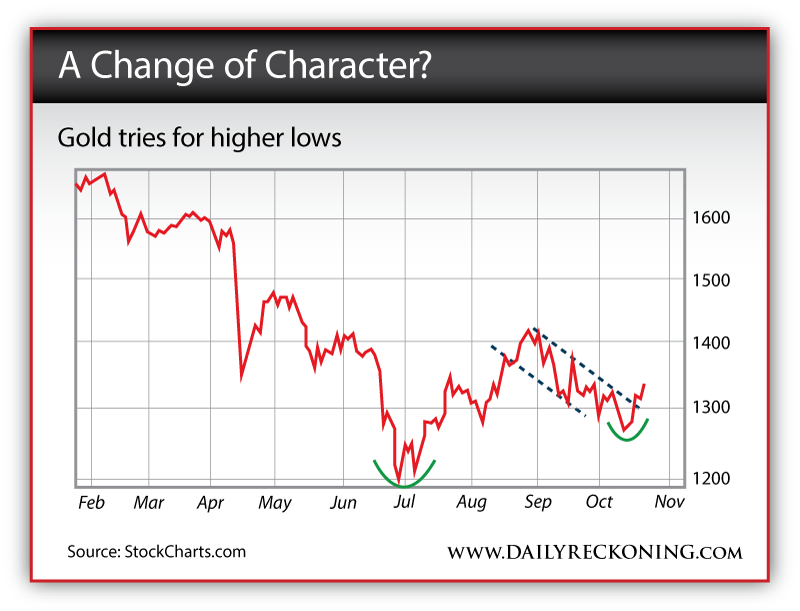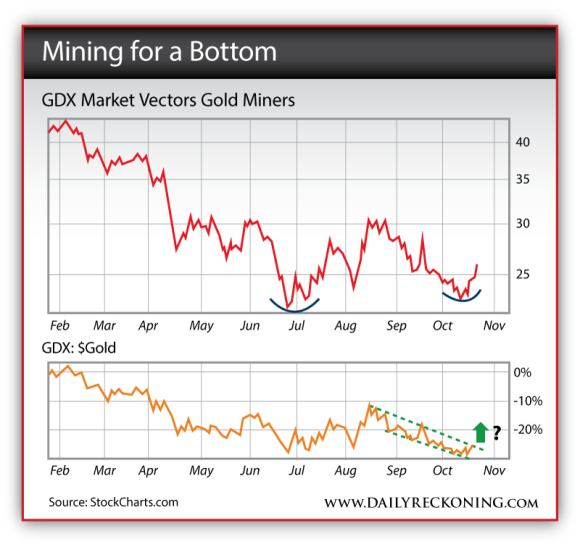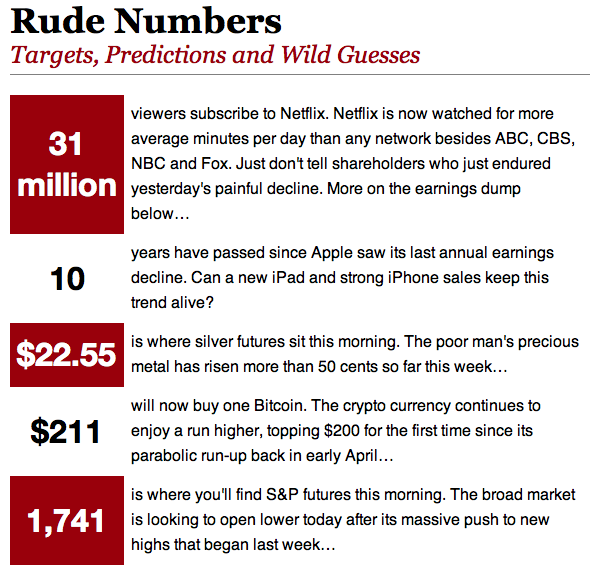Bonds & Interest Rates
Yesterday, the Labor Department reported that nonfarm payrolls (jobs) increased by 148,000 in September. Today’s chart provides some perspective in regards to the US job market. Note how the number of jobs steadily increased from 1961 to 2001 (top chart). During the last economic recovery (i.e. the end of 2001 to the end of 2007), job growth was unable to get back up to its long-term trend (first time since 1961). More recently, the number of nonfarm payrolls has been working its way higher but at a pace that is not fast enough to close the gap on its 1961 to 2001 trend. It is interesting to note that the current number of US jobs recently surpassed its 2001 peak. However, the job market has yet to reach the peak levels obtained back in early 2008.
Notes:
Where should you invest? The answer may surprise you. Find out right now with the exclusive & Barron’s recommended charts of Chart of the Day Plus.
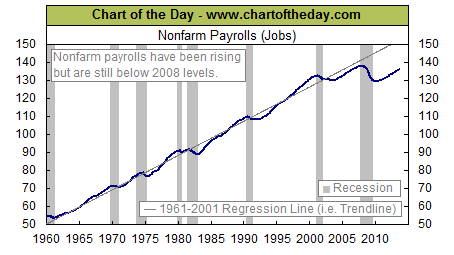

Quote of the Day
“People who work sitting down get paid more than people who work standing up.” – Ogden Nash
Events of the Day
October 24, 2013 – United Nations Day
October 31, 2013 – Halloween
November 02, 2013 – Breeders’ Cup
November 03, 2013 – Daylight Saving Time ends (US) – New York Marathon
Stocks of the Day
— Find out which stocks investors are focused on with the most active stocks today.
— Which stocks are making big money? Find out with the biggest stock gainers today.
— What are the largest companies? Find out with the largest companies by market cap.
— Which stocks are the biggest dividend payers? Find out with the highest dividend paying stocks.
— You can also quickly review the performance, dividend yield and market capitalization for each of the Dow Jones Industrial Average Companies as well as for each of the S&P 500 Companies.
Mailing List Info
Chart of the Day is FREE to anyone who subscribes. Click HERE to subscribe
To ensure email delivery of Chart of the Day, add mailinglist@chartoftheday.com to your whitelist

Few things are scarier for smart investors than buying when stock markets are at all-time record highs. With the S&P 500 (SNPINDEX: ^GSPC ) having soared to new records yesterday, sentiment among mainstream investors is unmistakably bullish. But subtler signs of nervousness have started to appear about the health of the economic recovery and the ability of the bull market to continue, raising fears that a stock market correction is imminent.
Ordinarily, investors can expect to see drops of 10% or more in the market roughly once a year, even in the context of an ongoing bull market. But the S&P 500 hasn’t suffered a 10% pullback since December 2011. With such a long period having gone by without a stock market correction, does it make sense to hold off on buying stocks in hopes of getting lower prices? Or should you go ahead and buy, risking getting mauled by a big bearish move?

Are you ready for what you’re wishing for?
Whenever there are extreme market movements in either direction, emotion starts to play a huge role in investing decisions. Extended and uninterrupted stock-market rallies, as we’ve seen throughout the past two years, leave those on the sidelines feeling increasingly worried that they’ve missed out on huge potential gains. This pushes them to invest even as higher share prices make stocks less attractive from a valuation standpoint. In that light, waiting for a correction might seem like the smarter move.
Yet, waiting creates two more challenges. First, you have to have the patience to stick with your decisions, and that can be difficult if the bull market rages higher. For instance, at the beginning of 2013, markets soared after lawmakers averted the threat of a huge tax increase on the entire American public. Those gains led some to decide to wait for a pullback before getting in. They’ve been waiting ever since, and the S&P 500 is now 20% higher.
Second, once the correction comes, you have to have the conviction to follow through with your original commitment to buy. That’s also a tough thing to do, because most stock market corrections hinge on some piece of exceptionally bad news that can make less secure investors question their entire investing plans.
Two smart moves to make now
What makes the most sense is never to stop investing entirely, even as markets keep rising, but also to keep your eyes open for better prospects if a stock market correction occurs. That way, you’ll benefit no matter which way the market moves.
When considering investments at near-record levels, it often pays to focus on areas of the market that most investors have neglected. Lately, consumer-staples stocks have gotten a huge amount of attention, with many investors turning to them for their reliable dividend income and defensive characteristics during pullbacks. Yet all the demand for dividend stocks has pushed their valuations up dramatically.
By contrast, commodity stocks, like gold miners and fertilizer producers, have gotten hammered. In the potash fertilizer space, PotashCorp (NYSE: POT ) and Mosaic (NYSE:MOS ) plunged during the summer when a key player in the global potash market backed out of a cartel agreement with its main partner, spurring speculation that potash prices would drop severely. It’s true that neither Mosaic nor PotashCorp owes its entire fortune to the potash industry, given that both also make other products that don’t rely on potash. Yet, short-term traders sold first and asked questions later, expecting the worst, and not wanting to get caught up in ongoing drama in the industry. For long-term investors who can afford to handle near-term uncertainty, the arguments favoring greater demand for crop-enhancing products like potash remain unchanged, and that should help Mosaic and PotashCorp recover eventually. That makes the two stocks worth looking at for their potential value opportunity.
At the same time, though, it also makes sense to look for stocks you’d want to buy if a stock market correction actually happens. Procter & Gamble (NYSE: PG ) has a lot of growth potential from global markets, but at 21 times trailing earnings, the shares reflect a premium for its 3% dividend yield and reputation as a defensive stock. Investors appreciate P&G’s brand success and its reliable demand from customers who see its products as essential staples. But paying too much for even the highest-quality consumer stock doesn’t make sense, especially when Procter & Gamble hasn’t yet delivered on its promise to expand its earnings power more rapidly. After a stock market correction, though, P&G shares could look a lot more attractive for the long run.
Be correct about a correction
Stock market corrections happen, and it pays to be ready for them. But you also have to be ready for them not to happen on any predictable time frame. Your best solution includes making the most of current opportunities while also setting the stage to jump on cheaper stocks when they emerge.
Start investing today!
Letting the lack of a stock market correction keep you from investing entirely would be a big mistake. Millions of Americans have done exactly that, waiting on the sidelines since the market meltdown five years ago and therefore missing the big bull market that followed. You can learn more about how to overcome your fears and invest by reading our brand-new special report, “Your Essential Guide to Start Investing Today.” Inside, The Motley Fool’s personal finance experts show you why investing is so important, and what you need to do to get started. Click here to get your copy today — it’s absolutely free.
Tune in to Fool.com for Dan’s regular columns on retirement, investing, and personal finance. You can follow him on Twitter @DanCaplinger.
About Dan Caplinger

Wall St Analyst Crams 700 Years Of Data Into Bearish Call On US Stocks
“The starting point of any financial analysis must surely be a consideration of the economic cycle: not just where we stand within the current cycle, but more importantly, where that cycle fits within broader economic history,” writes Paul Jackson in his final note to clients in his role as an equity strategist at Société Générale.
The note — titled “Swan song: 12 pictures you can’t ignore” — builds on the bank’s recent call for clients to rotate out of U.S. stocks and into European stocks. The SocGen asset allocation team predicts the S&P 500 will fall by around 15% when the Federal Reserve winds down its quantitative easing program, then go nowhere for years.
“For now, equity valuations in Europe are attractive and with a bit of economic growth the next few years could be quite rewarding,” says Jackson. “The immediate risks are that growth does not materialise in Europe or that the eurozone project unravels. For the longer term I worry more about latent inflation risks and central banks getting behind the curve. As bond markets react to that policy error, the folly of forcing banks, insurance companies and pension funds to hold so many bonds will become apparent. But that is for another day.”
1. Current inflation trends are boringly normal.
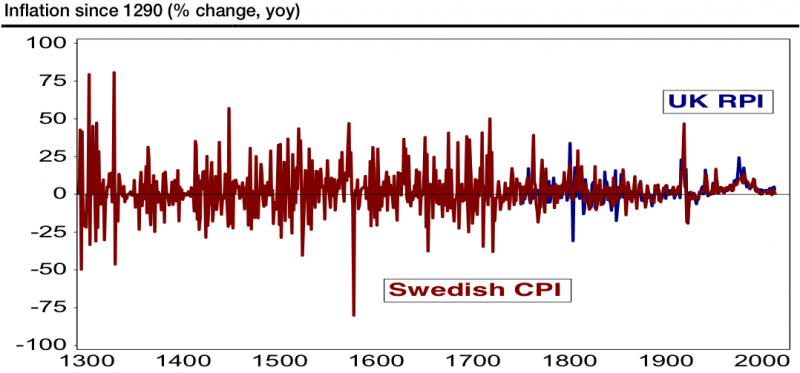
“Inflation may feel low compared to the history through which most of us have lived, but in a broader context it is boringly normal,” says Jackson. “Maybe without recent extra-ordinary policy settings, we would now be experiencing deflation, but we will never really know.”
…read and view much more HERE
2. Inflation has little effect on stock market valuation.
3. History suggests low returns ahead for U.S. stocks.
4. U.S. companies may be in for disappointment.
5. Europe’s economy has room to improve.
6. A better European economy means better European profits.
7. European stocks look attractive.
8. Many metrics suggest Europe is undervalued.
9. The real bubble is in the bond market.
10. The ECB’s balance sheet has been shrinking for a while.
11. The euro is getting a boost from ECB inaction.
12. The question is what happens when the Fed pulls back.




